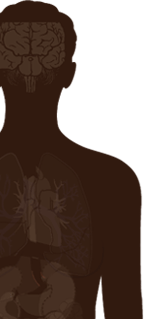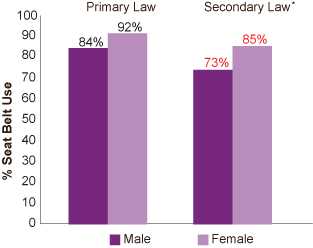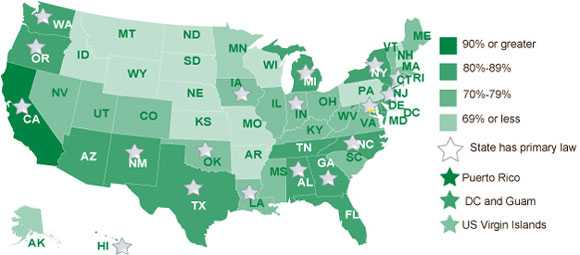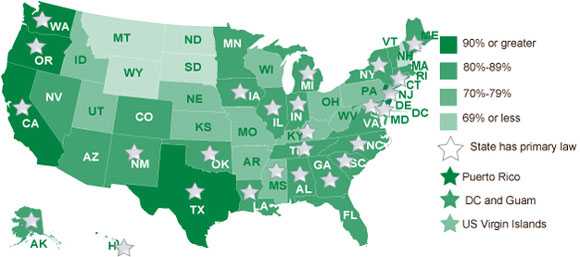Adult Seat Belt Use
January 2011


 6,400
6,400
Every day, about 6,400 adults are injured in a crash.
 50%
50%
Using seat belts reduces serious injuries and deaths in crashes by about 50%.
 7.3M
7.3M
7.3 million more adults would have worn their seat belts in 2008 if all states had primary enforcement seat belt laws achieved 88% use.*
Motor vehicle crashes are the leading cause of death for people age 5 – 34. Adult seat belt use is the single most effective way to save lives and reduce injuries in crashes. The percentage of adults who always wear seat belts increased from 80% to 85% between 2002 and 2008. Even so, 1 in 7 adults do not wear a seat belt on every trip. Primary enforcement seat belt laws make a big difference in getting more people to buckle up.* In 2010, 19 states–where 1 in 4 adult Americans live–did not have a primary law.
* A primary enforcement seat belt law means a police officer can pull someone over and issue a ticket to the driver just because someone in the vehicle is not wearing a seat belt. A secondary enforcement law allows a police officer to issue a ticket for someone not wearing a seat belt only if the driver has been pulled over for some other offense.
Problem
Millions of Americans are not protected from injury because they aren't wearing their seat belts on every trip.
Motor vehicle crashes are the leading cause of death for people age 5 – 34.
- More than 2.3 million adult drivers and passengers were treated in emergency departments for injuries from crashes in 2009.
- In one year alone, deaths and injuries to drivers and passengers from crashes cost $70 billion in medical and lost work.
- Young adults age 18-34 have the highest crash-related injury rates of all adults.
Many factors affect seat belt use.
- Adults age 18-34 are almost 10% less likely to wear a seat belt than adults 35 years or older.
- Men are 10% less likely to wear seat belts than women.
- Adults who live in rural areas are 10% less likely to wear seat belts (78% use) than adults who live in urban and suburban areas (87% use).
In 2009, about 12,000 more injuries would have been prevented and about 450 more lives saved if all states had primary enforcement seat belt laws.
Using a seat belt on every trip is the most effective way to prevent injury and death.
- Seat belt use reduces serious injuries and deaths in crashes by 50%. Air bags provide added protection but are not a substitute for seat belts in a crash.
- Seat belt use is higher in states that have primary enforcement laws (88%) than in those states that do not have them (79%).
- In 2009, about 12,000 more injuries would have been prevented and about 450 more lives saved if all states had primary enforcement seat belt laws.
- In 2010, 19 states–where 1 in 4 adult Americans live–did not have a primary law.


U.S. State Info
Seat belt use by type of law, US, 2002
In 2002, primary seat belt laws existed in 18 states, 3 territories, and the District of Columbia. These laws covered about 53% of the US adult population.

Seat belt use by type of law, US, 2008
In 2008, primary seat belt laws existed in 26 states, 3 territories, and the District of Columbia. These laws covered about 65% of the US adult population.

SOURCE: CDC Behavioral Risk Factor Surveillance System, US, 2002 and 2008
What Can Be Done
States can
- Pass a primary enforcement seat belt law.
- Make sure that seat belt laws apply to everyone in the car, not just those in the front seat.
- Ensure that fines for not wearing a seat belt are high enough to be effective.
- Make sure that police and state troopers enforce all seat belt laws.
- Support seat belt laws with visible police presence and awareness campaigns for the public.
- Educate the public to make seat belt use a social norm.
Employers can
- Post information in break rooms and parking lots that encourages employees to buckle up.
- Identify the cost of car crashes to their workforce in terms of medical care and lost wages.
- Require seat belt use in company vehicles at all times, and in personal vehicles while on company business.
- Develop active enforcement programs for staff about seat belt use when driving company vehicles.
Everyone can
- Use a seat belt on every trip, no matter how short.
- Encourage all passengers in the car to buckle up, including those in the back seat.
Parent and caregivers can
- Use a seat belt on every trip, no matter how short. This sets a good example.
- Make sure children are properly buckled up in a seat belt, booster seat, or car seat, whichever is appropriate.*
- Have all children age 12 and under sit in the back seat.
- Never seat a child in front of an air bag.
- Place children in the middle of the back seat when possible, because it is the safest spot in the vehicle.
Health professionals can
- Encourage patients to make wearing a seat belt a habit.
- Wear seat belts themselves and encourage their colleagues to do the same.
- Remind patients about the importance of seat belt use.
*Motor vehicle crashes are also a leading cause of death among children. To learn more about which type of safety seat is best for your child’s age and size, visit www.cdc.gov/motorvehiclesafety.
Science Behind the Issue
Related Pages
- Morbidity and Mortality Weekly Report (MMWR): Vital Signs: Nonfatal, Motor Vehicle–Occupant Injuries (2009) and Seat Belt Use (2008) Among Adults — United States
- CDC – Motor Vehicle Safety
- Seat Belts – What You Need to Know [PODCAST – 1:20 minutes]
- Seat Belts- What You Need to Know [PSA – 1:00 minute]
On Other Web Sites
- Page last reviewed: January 4, 2011
- Page last updated: January 4, 2011
- Content source:
- National Center for Injury Prevention and Control, Division of Unintentional Injury Prevention
- Page maintained by: Office of the Associate Director for Communications (OADC)


 ShareCompartir
ShareCompartir